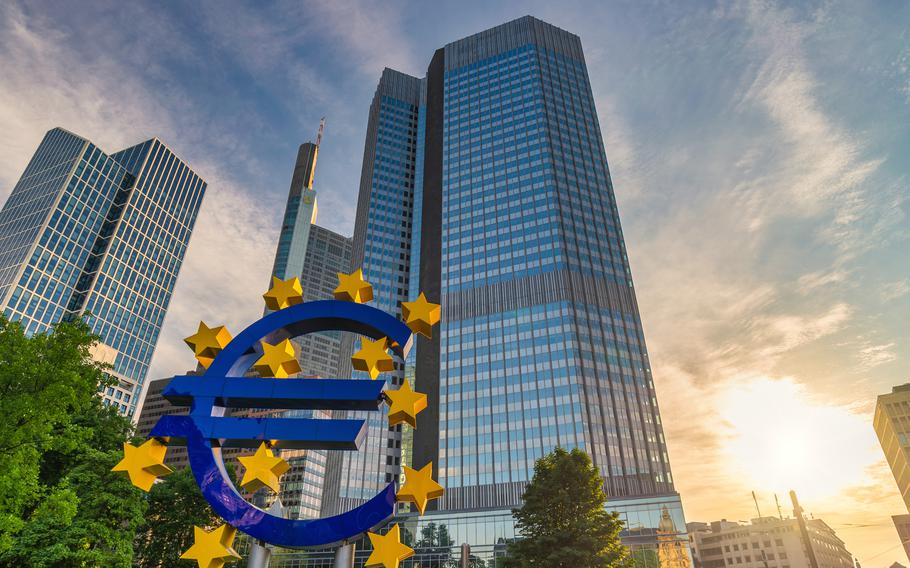
The European Central Bank in Frankfurt, Germany, welcomes visitors and offers a free 90-minute tour on weekdays. (iStock)
From June 6-9, the citizens of the countries that make up the European Union will head to the polls and vote for their Members of the European Parliament, or MEPs. As part of a process that takes place once every five years, EU citizens enjoy the privilege of choosing their representatives to the world’s only directly elected transnational assembly. Working in close cooperation with the governments of EU countries, these MEPs shape and decide on the legislation that heavily influences lives across the European Union.
But first, let’s step back a bit. What is the European Union, exactly? In contrast to Europe, a geographical space, the EU is an economic and political union between 27 countries. With deep roots in a number of treaties signed in the aftermath of WWII, its initial purpose was to foster economic cooperation, based on the idea that economically interdependent countries are more likely to avoid conflict. What began as a strictly economic union has since evolved into an organization spanning many different policy areas, from climate, environment and health to external relations and security, justice and migration.
As a quick refresher, the countries of the European Union are: Austria, Belgium, Bulgaria, Croatia, Cyprus, the Czech Republic, Denmark, Estonia, Finland, France, Germany, Greece, Hungary, Ireland, Italy, Latvia, Lithuania, Luxembourg, Malta, Netherlands, Poland, Portugal, Romania, Slovakia, Slovenia, Spain and Sweden. (The United Kingdom left the EU in 2020.)
These elections provide us with a timely pretext to look at some of the institutions of the EU and how to go about exploring them.
EU seats of power: In an arrangement incorporated into the EU treaty since 1997, the institutions of the EU have three primary locations: the official seat and venue for most plenary sessions is Strasbourg, France; parliamentary committees meet in Brussels, Belgium; and Parliament’s Secretariat (administrative staff) is based in Luxembourg. Both the Strasbourg and Brussels locations welcome individual visitors; Luxembourg accommodates groups only. To enter these premises, an official form of identification such as a valid national ID card or a passport is a must, and visitors are likely to find themselves subject to airport-style security checks.
Strasbourg: The European Parliament welcomes visitors whenever plenary sessions are not being held. Visitors can experience the Hemicycle, the Parlamentarium Simone Veil and various permanent and temporary exhibitions. A self-guided tour takes about one hour and is free of charge. Opening hours are 9 a.m.-6 p.m. Mon.-Fri and 9:30 a.m.-noon and 1 p.m.-6 p.m. Saturdays. The entry, located at Louise Weiss Building, 1 Allée du Printemps, is easily reached by public transportation. Online: tinyurl.com/2s3pscd4
Brussels: A visit to the Parlamentarium entails a multimedia-led journey through European history and integration, followed by an introduction to the functioning of the Parliament. An interactive floor map takes visitors on a virtual tour around Europe, highlighting the diversity of the countries of the continent. These visits, free of charge, take about 1.5 hours and can be experienced 1 p.m.-6 p.m. on Mondays, 9 a.m.-6 p.m. Tues.-Fri. and 10 a.m.-6 p.m. Sat and Sun. The visitor center is located at Esplanade Solidarność 1980. Online: tinyurl.com/4vwyc4cs
Other EU places
Europa Experience is the name given to multimedia spaces around Europe that offer insight into how the European Union works, how it affects the daily life of its citizens and how the EU nations work together to tackle today’s most important challenges. Depending on the facility, visitors can explore maps of the countries that illustrate progress made and the issues still to overcome; watch informational videos in a cinema, take photos in a photo booth or hear stories from EU citizens about how the union has impacted their lives. Europa Experience spaces are found in Berlin, Copenhagen, Luxembourg, Paris, Prague, Rome, Stockholm, Vienna, Ljubljana, Slovenia; Tallinn, Estonia; and Warsaw, Poland. All such centers welcome visitors free of charge. Online: tinyurl.com/26p3v9rh
Frankfurt am Main, Germany: The European Central Bank, or ECB, is the central bank of the European Union countries that use the euro. The ECB strives to maintain price stability by keeping inflation low, stable and predictable. The ECB Visitor Centre, located in the ECB’s main building at Sonnemannstrasse 20, sheds light on the bank’s role and responsibilities by means of interactive exhibits, videos and Q&A sessions. These 90-minute tours are offered free of change Mondays through Fridays and should be booked in advance on the ECB website. Online: tinyurl.com/597ntp3a
Brussels, Belgium: The House of European History takes visitors on a journey along the long and winding road of the Continent’s past, exploring its myths and discoveries and times of chaos and cohesion, before challenging them to contemplate Europe’s future. The facility’s setting, a handsomely renovated building in a leafy park, is a treat unto itself. A visit, which takes around 90 minutes, is free. Opening hours are 1 p.m.-6 p.m. Mon., 9 a.m.-6 p.m. Tues.-Fri. and 10 a.m.-6 p.m. Sat. and Sun. The building is located at Rue Belliard/ Belliardstraat 135.
A temporary exhibition titled “Bellum et Artes – Europe and the Thirty Years’ War” brings together outstanding 17-century artworks from collections across the Continent to explore the role arts played during this dark period of history. The exhibition runs until Jan. 12, 2025. Online: historia.europa.eu/en/visit